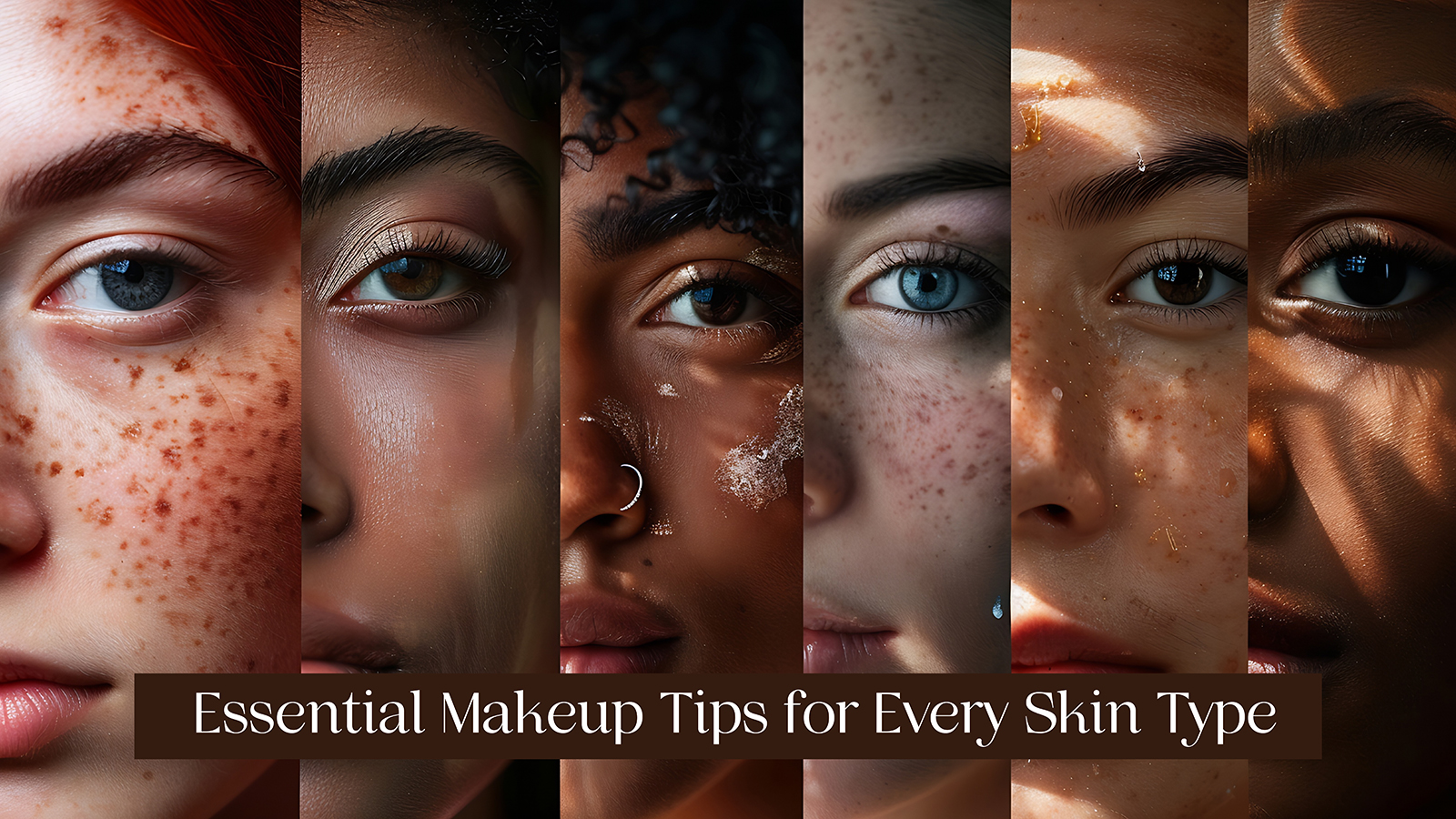Essential Makeup Tips for Every Skin Type


Skin types play a crucial role in how makeup interacts with the skin. Understanding and adjusting to different skin types — not just the facial makeup products — is crucial for any makeup artist aiming to achieve the best results. Whether it’s dealing with oily, dry, combination, sensitive, or acne-prone skin, each type requires a unique approach to ensure that the makeup not only looks good but also lasts throughout the day. This blog provides MUA tips and a comprehensive guide on how to identify and work with different skin types, tailoring your approach for a stunning result every time.
Oily Skin
- What It Means: Oily skin tends to have enlarged pores and a shiny complexion which can make makeup slip if not handled correctly.
- Makeup Prep Tips: Start with an oil-control cleanser and toner, followed by a mattifying good quality primer to reduce shine.
- MUA Tips for Application: Use oil-free and long-lasting products. Powder-based products work well to set the makeup without adding extra shine.
- Why This Works: Mattifying products prevent oil build-up, keeping the makeup intact and reducing the need for touch-ups.

Embracing Oily Skin: Techniques for Matte Perfection
Oily skin, characterised by excess sebum production, can challenge your makeup’s longevity. Starting with a mattifying good quality primer sets a solid base, reducing shine and extending the wear of your foundation. Opt for powder-based foundations or setting powders that absorb excess oil without clogging pores. For photo-ready moments, a light dusting of translucent powder on shiny areas can enhance your matte finish while keeping the skin’s natural glow.
FAQs
:
- Q: How often should I touch-up makeup on oily skin?
- A: Minimise touch-ups to avoid caking. Ideally, once every 4-5 hours, use blotting papers followed by a light dusting of powder.
- Q: Can I use a highlighter on oily skin?
- A: Yes but apply sparingly and opt for powder-based highlighters rather than cream or liquid forms.
Dry Skin
- What It Means: Dry skin can appear dull and rough with visible fine lines and flakiness, which can get highlighted if makeup is not done right.
- Makeup Prep Tips: Hydration is key. Use a rich moisturiser and a hydrating good quality primer to create a smooth and supple base.
- MUA Tips for Application: Choose creamy foundations and concealers that offer hydration along with coverage.
- Why This Works: Moisturising products help smooth out flakiness and fine lines, providing a seamless canvas for further makeup application.

Nourishing Dry Skin: Achieving a Dewy Glow
Dry skin requires a hydration-focused routine to prevent flakiness and patches. Begin with a hydrating cleanser followed by a rich moisturiser to smooth and prepare the skin for makeup. Choose foundations with a dewy or satin finish, avoiding matte or powder-based types that can highlight dry areas. Incorporate facial oils or hydrating serums that lock in moisture, providing a plump and radiant base for your makeup.
FAQs:
- Q: What type of foundation is best for dry skin?
- A: Liquid or stick foundations with hydrating formulas are ideal.
- Q: How can I prevent makeup from clinging to dry patches?
- A: Regular exfoliation and thorough moisturising are key to preventing makeup from clinging to dry areas.
Combination Skin
- What It Means: Combination skin features both oily and dry areas, which requires a balanced approach to makeup.
- Makeup Prep Tips: Use a balancing toner and consider applying different primers on different face areas — mattifying on the T-zone and hydrating on dry patches.
- MUA Tips for Application: You might need to mix foundation types or use strategic powdering to address different needs.
- Why This Works: Tailored application ensures that each area of the face receives the attention it needs, resulting in a harmonious finish.
Balancing Combination Skin: The Best of Both Worlds
Combination skin features both oily and dry patches, necessitating a versatile approach. Use a gentle cleanser followed by a lightweight moisturiser that doesn’t weigh down the skin. Apply a mattifying primer in oily zones and a hydrating good quality primer in dry areas to create a balanced surface. Foundation should be applied strategically – lightly where the skin is oily and more generously where it is dry.
FAQs:
- Q: Can I use the same moisturiser for all areas of my combination skin?
- A: It’s better to use two different moisturisers catering to the specific needs of the oily and dry areas.
- Q: How do I prevent the foundation from oxidising on oily areas?
- A: Use a good quality primer and set with a good quality powder to minimise
Sensitive Skin

- What It Means: Sensitive skin reacts easily and can become red or irritated with certain makeup products.
- Makeup Prep Tips: Choose hypoallergenic, fragrance-free products to minimise risk. Conduct a patch test for new products.
- MUA Tips for Application: Apply makeup gently using tools that won’t irritate the skin, like soft sponges or brushes.
- Why This Works: Minimising irritation will make the makeup session more comfortable and prevent post-makeup skin issues.
FAQs:
- Q: What ingredients should I avoid for sensitive skin?
- A: Avoid alcohol, fragrances, and parabens which can be irritating.
- Q: Is mineral makeup good for sensitive skin?
- A: Yes, mineral makeup is often recommended because it’s free from potentially irritating chemicals.
Acne-Prone Skin
- What It Means: Acne-prone skin needs careful handling to conceal blemishes without causing further breakouts.
- Makeup Prep Tips: Use non-comedogenic and oil-free products to avoid clogging pores.
- MUA Tips for Application: Use techniques that offer coverage while allowing the skin to breathe. Avoid heavy layering to prevent clogged pores.
- Why This Works: Non-comedogenic products reduce the risk of new breakouts and light application helps prevent aggravating existing acne.

FAQs:
- Q: How can I cover up acne without using too much makeup?
- A: Focus on spot-concealing with a high-coverage concealer and keep the rest of your base light.
- Q: What type of primer should I use for acne-prone skin?
- A: Look for mattifying primers that contain salicylic acid or zinc which can help control breakouts.
Special Considerations: Pores, Pigmentation, and Sweat Control
No matter your skin type, addressing enlarged pores, pigmentation, and sweat can elevate your makeup application. Pore-minimising good quality primers can smooth the skin’s texture, providing a more even canvas. For pigmentation issues, colour-correcting concealers work wonders before foundation application. To combat sweat, especially in warmer climates or during long events, setting sprays and powders are essential to lock makeup in place and reduce the need for touch-ups.

Conclusion
Mastering makeup application for various skin types not only sets a professional MUA apart, but also ensures client satisfaction and repeat business. By understanding and implementing these tailored approaches, you ensure that everyone leaves your makeup chair looking their best. Remember, each skin type has its unique needs and understanding these can transform your makeup applications from good to great. Dive deeper into each type and elevate your makeup artistry to new heights!






